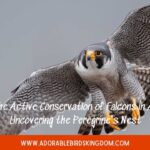I’ve always been fascinated by the impressive array of wildlife that calls Kansas home. Among them, hawks stand out as some of the most captivating creatures. With their sharp eyes, powerful wings, and incredible hunting skills, they’re truly a sight to behold.
Kansas, with its wide-open spaces and diverse habitats, is a haven for these majestic birds. From the Red-tailed Hawk, often spotted soaring over open fields, to the Cooper’s Hawk, known for its acrobatic flights in wooded areas, you’ll find a variety of species here.
As you delve deeper into the world of Kansas hawks, you’ll discover intriguing facts and behaviors that make these birds unique. So, let’s embark on this journey together, exploring the lives of these incredible predators of the Kansas skies.
Exploring the World of Kansas Hawks
When you’re traveling through Kansas, don’t forget to look up. You’ll often catch a glimpse of the majestic hawks that call this region home. Let me guide you through these winged wonders and their captivating lives in the heartland of America.
Kansas provides an ideal habitat for several types of hawks, each with unique traits and behavior. The Red-tailed Hawk, with its rufous tail and broad wingspan, soars high above the plains. It’s well-adapted to open areas, a hunter par excellence in the Kansas sky.
In contrast, the Cooper’s Hawk prefers woodland habitats, quietly stalking its prey in a cat-and-mouse game of life and death. It’s smaller, sleek, and agile, darting through the trees with skillful precision.
There’s also the Swainson’s Hawk. During the long, hot Kansas summers, these birds flood the open range, providing a fascinating spectacle of nature.
The following markdown table outlines three primary hawk species in Kansas:
| Hawk Species | Key Characteristics | Preferred Habitat |
|---|---|---|
| Red-tailed Hawk | Broad wingspan, rufous tail | Open spaces |
| Cooper’s Hawk | Agile, smaller size | Woodlands |
| Swainson’s Hawk | Migratory, summer visitor | Open range |
Kansas isn’t just a plain state – it’s a haven where life in the air thrives. As we delve deeper into the world of Kansas hawks, we uncover behaviors, skills, and adaptations that truly make these creatures remarkable.
Red-tailed Hawk: The Iconic Raptor of the Plains
Moving our journey across the multifaceted terrain of Kansas, our lens focuses on the distinctive silhouette of the Red-tailed Hawk. Towering over open fields – it earns its reputation as a beacon of the prairies.
Among the many hawk species found in Kansas, the mighty Red-tailed Hawk possesses a singular presence. Equipped with keen eyes that peer from high vantage points and broad, rounded wings aiding in long, effortless flights – it’s the very depiction of sky supremacy. Not to mention the distinguishing feature that crowns this bird: a rich, rust-red tail that glows under the sun.
The Red-tailed Hawk, or Buteo jamaicensis if you prefer the scientific touch, thrives in areas offering expansive views. This includes a generous spread of open fields, deserts, roadsides, and evergreen forests. To the everyday onlooker, spotting one could be as easy as glancing at the perches around – lamp posts, fences, or the lofty tree branches – as the Red-tailed Hawk often stands sentinel around human habitats.
Remain unwavering in the face of strong windy currents, the Red-tailed Hawk displays an adept mastery over the art of soaring. Precise control over wing movements while circling into thermal updrafts, it’s an aerial spectacle to behold. Alongside its aerial prowess, this bird’s attack strategy deserves all bragging rights. With a swift and decisive plunge, it captures its unsuspecting prey, a testament to its superior predatory instincts.
This innate predatory nature commands a varied diet comprised mostly of small mammals, birds, and reptiles. In Kansas, the Red-tailed Hawk goes for field mice, gophers, ground squirrels, and other rodents – a testament of its adaptability.
Far from being just a sky dominator, the Red-tailed Hawk also exemplifies an intriguing social structure. Mating pairs, once formed, stick together for the long haul, usually nesting in the same territory year after year. A display of loyalty worthy of applause!
Without a doubt, the Red-tailed Hawk confidently places itself as not just a symbol but as a proud declaration of the richness and diversity that the Kansas skies offer.
Cooper’s Hawk: The Agile Hunter of Woodlands
As we talk about the rich diversity of hawks, we simply can’t miss the Cooper’s Hawk. Named after naturalist William Cooper, these agile creatures are true masters of the forest realms.
Known as Accipiter cooperii in scientific circles, Cooper’s Hawks are often identified by their slate gray or brownish upper bodies, with lighter underparts streaked with red or brown. What sets them apart is their long, rounded tail marked with dark bands. They’re medium-sized, sure. But don’t let their size fool you. These birds are formidable hunters, chasing after smaller birds with agility and grace in dense woodlands.
These woodlands form their preferred habitat. In Kansas, you’re most likely to spot them in large trees around forest edges, parks, and even backyard bird feeders. They’ve made quite a place for themselves in urban and suburban settings, showcasing platonic adaptability.
Their hunting technique is a spectacle in and of itself. They’re stealth hunters, relying on the element of surprise. They’ll patiently watch and wait in low-level perches. And when the time comes, they pounce on their unsuspecting target with remarkable speed and precision.
Let’s take a look at their preferred menu:
| Cooper’s Hawk’s Diet |
| Small Mammals |
| Birds |
| Insects |
| Occasional reptiles |
That’s right. They’ve been known to occasionally snack on small reptiles too, making them a vital part of maintaining the local ecosystem.
When it comes to social structure, Cooper’s Hawks are monogamous and territorial. You’ll often find them living in the same geographic areas year after year. Their fidelity to their mates and their territory demonstrates unique loyalty among raptors. It’s another proud reminder of the richness of the Kansas skies.
Fascinating Behaviors of Kansas Hawks
I’ve always been mesmerized by hawks and their intriguing behaviors. As a bird watcher and nature enthusiast, my most memorable experiences have been observing these powerful Kansas natives.
One interesting behavior that I would like to shed light on is the hawks’ predation pattern. In Kansas, hawks play a crucial role in controlling the population of smaller birds and mammals. They’re not fond of carrions; they rather prefer hunting their meals live. On a calm day, you might just spot a hawk circling the skies, scanning the ground for prey, showcasing their exceptional vision.
Their flight pattern is a sight to behold. Hawks have a unique ability to identify thermal columns in the air to help them glide and save energy. They can ride these ‘hot air elevators’, navigating long distances without a single flap of their wings.
Kansas hawks show exemplary courting behavior. It’s no less than an air show when male hawks perform their death-defying dives and climbs to impress prospective mates. During breeding season, their nests become a hub of activity.
Moreover, these birds exhibit strong territorial instincts. A hawk patrolling its territory is not a sight you’d forget easily. Intruding hawks are often given chase, followed by warning calls and aerial fights. Alternatively, they’ve been observed to use a ‘soaring display’, circling the sky to mark their territory.
It’s also worth noting their communication in the sky. Hawks use a variety of calls, each with distinct meanings, effectively communicating their intentions. Whether it’s to signal impeding danger, mark territory or secure a mate, each call is specific and decisive in its message.
| Interesting Hawk Behavior | Brief Explanation |
|---|---|
| Preserving energy with thermal columns | Use ‘hot air elevators’ to fly and navigate long distances |
| Exemplary courting behavior | Males perform death-defying dives and climbs to attract mates |
| Territorial instincts | Showcasing fierce aerial fights, soaring displays, and warning calls |
| Varied communication calls | Use of distinct calls to signal danger, mark territory, or secure a mate |
The Cooper’s Hawk truly stands out among other bird species in Kansas for its fascinating behaviors and unique adaptations.
Conservation Efforts and Future of Hawks in Kansas
Over the years, conservation efforts have led to the stabilization of hawk populations in Kansas. It’s due to the tireless work of organizations like the Kansas Department of Wildlife, Parks, and Tourism, Audubon of Kansas, and the National Wildlife Federation, among others. Their strategies include habitat restoration, public education, regulations on hunting and trapping, and the rehabilitation of injured hawks.
Habitat restoration is of utmost importance. Humans’ encroachment into hawk territories often leads to habitat destruction, which further affects the diversified food web. Restoring natural habitats ensures the survival of these apex predators and maintains the balance in the ecosystem.
Public education initiatives have also increased in recent years. The goal is to promote the significance of hawks in the ecosystem and dispel any misconceptions. Most people aren’t aware of the key role these birds play so education is essential. I’ve attended several initiatives where they use interactive displays, guided hikes, and bird watching trips to create a personal connection between the public and hawks. If we respect their presence and role, we’re more likely to support and participate in their conservation.
Furthermore, the diligent monitoring and regulation of hunting and trapping activities ensure that these actions do not negatively impact hawk populations. Hawks are now protected under the Migratory Bird Treaty Act, which mandates penalties for unauthorized hunting, trading, or possession.
Rehabilitation centers play a critical role as well. These facilities provide medical care to injured hawks, eventually reintegrating them back into the wild. They serve as lifeboats for these majestic creatures, dramatically improving their chances of survival.
Looking to the future, the combination of these efforts paints a brighter picture for the hawks of Kansas. But there’s still so much left to do. Thus, the conservation efforts must continue, with the hope of securing a thriving and sustainable future for these birds.
As for the Cooper’s Hawk, its adaptive qualities make it a resilient bird species. We look forward to seeing them soar in great numbers across the Kansas skies for many more years.
Conclusion
So, we’ve journeyed through the world of Kansas hawks, discovering their unique behaviors and the importance they hold in our ecosystem. We’ve seen first-hand the incredible work being done by local organizations to protect, nurture, and educate about these birds. It’s clear that their efforts are paying off, with hawk populations stabilizing and even thriving in some areas. The survival and prosperity of these majestic creatures, particularly the resilient Cooper’s Hawk, is a testament to the power of conservation. As we move forward, let’s continue to support these initiatives and ensure a sustainable future for Kansas hawks. After all, our actions today shape the world of tomorrow.



